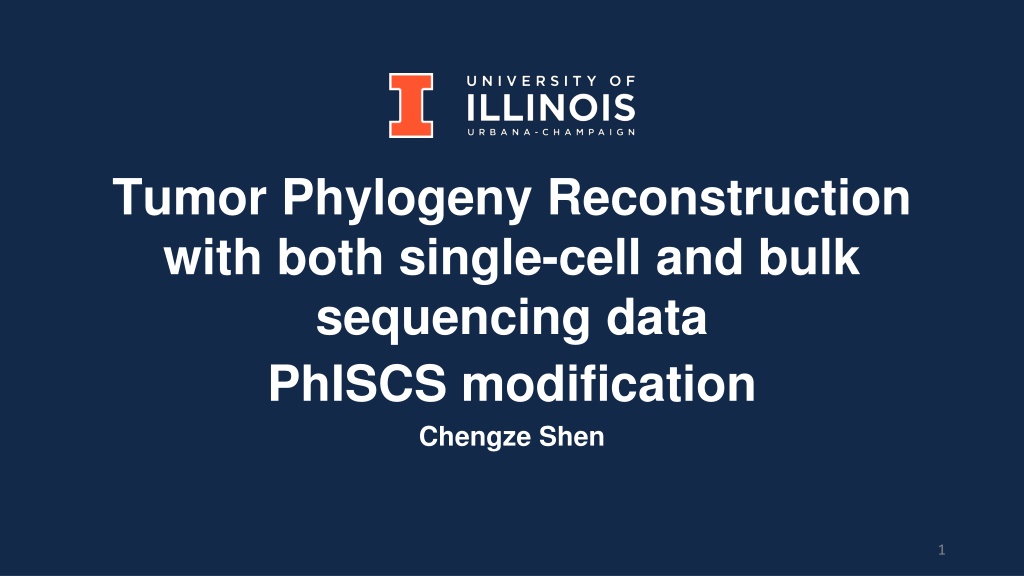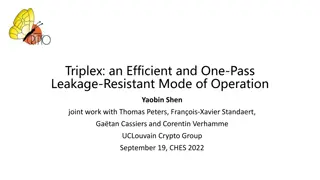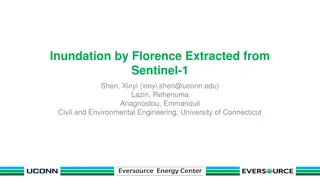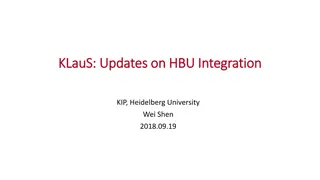
Tumor Phylogeny Reconstruction: PhISCS and Single-Cell Sequencing
Explore tumor phylogeny reconstruction using PhISCS with both single-cell and bulk sequencing data. Understand intra-tumor heterogeneity and evolutionary history for effective cancer treatments. Learn about incorporating single-cell data, addressing ISA violations, and maximizing conditional probability.
Download Presentation

Please find below an Image/Link to download the presentation.
The content on the website is provided AS IS for your information and personal use only. It may not be sold, licensed, or shared on other websites without obtaining consent from the author. Download presentation by click this link. If you encounter any issues during the download, it is possible that the publisher has removed the file from their server.
E N D
Presentation Transcript
Tumor Phylogeny Reconstruction with both single-cell and bulk sequencing data PhISCS modification Chengze Shen 1
Brief Introduction Intra-tumor heterogeneity (ITH) casts profound impacts on cancer treatment effects, therefore it is crucial to understand tumor evolutionary history for designing effective treatments. There exist some methods studying ITH via single-cell sequencing (SCS) data (e.g., SCITE) or via both SCS and bulk sequencing data (e.g., B-SCITE, ddClone). PhISCS studies ITH with both SCS and bulk sequencing data, accounts for infinite site assumption (ISA), and builds a tumor mutation phylogeny as one of the outputs. 2
Overview PhISCS-I (the ILP version of PhISCS) 1. Incorporating SCS data with ISA violation 2. Addition of bulk sequencing data Potential improvements on PhISCS 1. ISA penalty 2. Few SCS data points 3. Ambiguous SCS data points 3
Overview PhISCS-I (the ILP version of PhISCS) 1. Incorporating SCS data with ISA violation 2. Addition of bulk sequencing data Potential improvements on PhISCS 1. ISA penalty 2. Few SCS data points 3. Ambiguous SCS data points 4
Incorporating SCS data with ISA violation Input (SCS data) Mut 1 Mut 2 Mut 3 Mut 4 Mut 1 Mut 2 Mut 3 Mut 4 Cell 1 0 0 1 1 Cell 1 0 0 1 1 Cell 2 0 1 1 0 Cell 2 0 1 1 1 Cell 3 0 ? 0 1 Cell 3 0 0 0 1 Cell 4 ? ? 1 1 Cell 4 1 0 1 1 Bit assignment & Bit flipping Ternary matrix I This corrected matrix provides perfect phylogeny (PP) I(i,j) = 0 means the absence of mutation j in single cell i; I(i,j) = 1 means the presence; I(i,j) = ? means the status is unknown (missing entries). * Green box here marks an ISA violation 5
Incorporating SCS data with ISA violation Let matrix Y be the true status matrix for the SCS data Y(i,j) is the true status of mutation j in cell i. Assume we have as the FN rate, and as the FP rate for the SCS data. Then we have We can further combine the terms for I(i,j) and obtain 6
Incorporating SCS data with ISA violation The objective is to maximize the conditional probability P(I | Y), assuming the missing entries are non- informative Plug in the expressions from last slide, we want to maximize the following 7
Incorporating SCS data with ISA violation The authors add the following constraints to maintain the property of a newly introduced matrix B B(p,q,a,b) = 1 indicates there exists a single cell r, such that its mutation p and q are a and b, correspondingly. And the following constraint to enforce the three-gametes rule 8
Incorporating SCS data with ISA violation If we consider ISA violation, we introduce another variable K to keep track of the mutations we eliminate (loss of heterogeneity). Therefore, we can modify our three-gamete-rule constraint as and the objective function to consider ISA violation 9
Overview PhISCS-I (the ILP version of PhISCS) 1. Incorporating SCS data with ISA violation 2. Addition of bulk sequencing data Potential improvements on PhISCS 1. ISA penalty 2. Few SCS data points 3. Ambiguous SCS data points 10
Potential improvement - ISA penalty In PhISCS, since the objective function includes whether we eliminate a mutation q using K(q), naively we can set all K(q)=1 so the objective is maximized. PhISCS prevents this from happening by having a user-defined upper bound for number of eliminations, as . Instead, we could incur a penalty term based on mutation q, so that we do not need to explicitly set how many mutations we want to eliminate. I tried the most naive case where is a constant. 11
Potential improvement - ISA penalty Test case 0 0 0,1 0,3 3 4 0,3,5 0,1,2 6 5 Lost 1 0,1,2,4 0,2,4 Lost 2 0,4,6 7 mutations, and two sets of ISA violations. 12 single cells generated from the left figure (all nodes are covered). 12
Potential improvement - ISA penalty PhISCS, setting numbers of mutation eliminations kmax=0 kmax=1 kmax=2 Eliminated mut1 Eliminated mut2, mut4 13
Potential improvement - ISA penalty Modified PhISCS, = 1 Also tried = 15 And = 50 Very intuitive: higher the penalty term, fewer eliminations incurred. A simple gamma suffices to find the correct tree in this testing case. The gamma should be chosen such that it is related to the FN/FP rates. 14
Potential improvement - ISA penalty More testing cases are run on sim1a studied in PhyDOSE [2]. A total of 10 replicates are run, and each replicate contains 100 subsampled cells with 7 mutations. Currently calculating average RF errors for the estimated mutation evolutionary tree. 15
Potential improvement - ISA penalty Further thing to try to penalize ISA violation would involve using a more complex penalty term that takes other information into account: 1. Mutation prevalence 2. Mutation uncertainty 16
Overview PhISCS-I (the ILP version of PhISCS) 1. Incorporating SCS data with ISA violation 2. Addition of bulk sequencing data Potential improvements on PhISCS 1. ISA penalty 2. Few SCS data points 3. Ambiguous SCS data points 17
Few SCS data points When SCS data points are few, how/how much is the output tree impacted? * Test case, no error, no missing entries 2 5 6 0 3 1 4 20 single cells 100 single cells 18
Overview PhISCS-I (the ILP version of PhISCS) 1. Incorporating SCS data with ISA violation 2. Addition of bulk sequencing data Potential improvements on PhISCS 1. ISA penalty 2. Few SCS data points 3. Ambiguous SCS data points 20
Ambiguous SCS data points When SCS data points contain many missing entries, how/how much is the output tree impacted? * Test case, 100 single cells, no error 2 5 6 0 3 1 4 No missing entries 50% missing entries 21
Coming up 1. Benchmark results on datasets with errors. 2. Calculate RF error rate for the predicted phylogeny tree versus the true evolutionary tree. 3. Finish improvement #2 and #3. 22
References 1. Malikic S, Mehrabadi FR, Ciccolella S, Rahman MK, Ricketts C, Haghshenas E, Seidman D, Hach F, Hajirasouliha I, Sahinalp SC. PhISCS: a combinatorial approach for subperfect tumor phylogeny reconstruction via integrative use of single-cell and bulk sequencing data. Genome Res. 2019 Nov;29(11):1860-1877. doi: 10.1101/gr.234435.118. Epub 2019 Oct 18. PMID: 31628256; PMCID: PMC6836735. 2. Weber LL, Aguse N, Chia N, El-Kebir M (2020) PhyDOSE: Design of follow-up single-cell sequencing experiments of tumors. PLoS Comput Biol 16(10): e1008240. https://doi.org/10.1371/journal.pcbi.1008240 23




